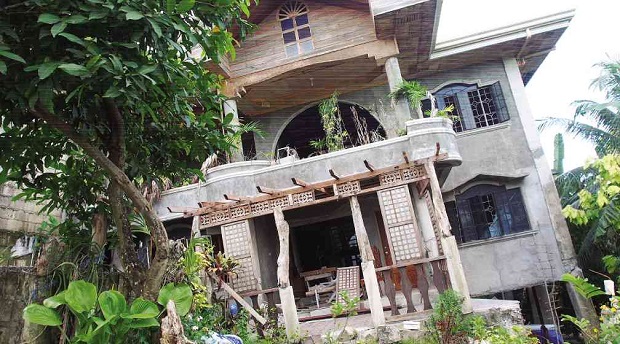The 7.2-magnitude temblor that shook Bohol and Cebu provinces on Oct. 15 took away lives and damaged not just the old churches in Bohol. It also put in disarray properties, particularly houses.
Left with nothing to rebuild their houses with, some families living in tents wonder if they can still salvage parts of their abode.
It took 10 years for the Anquilero clan of Maribojoc to build their P2.1-million house. The first floor of the 396-square-meter, three-story structure (132 sq m each floor) was flattened. The house’s beams and tiles, however, were left intact.
Three Anquilero families were living in this house when the earthquake struck. Across the street from where the house stood, the centuries-old Maribojoc church was reduced to a pile of rubble, attesting to the power of the temblor.
Inquirer Property chanced upon members of the Anquilero family on Dec. 15, during a tour of the damaged Bohol churches, after a Dec. 13 Inquirer Read-Along session with children of devastated Sagbayan town in central Bohol.
THE ANQUILEROS Belen, Dorothea, Roque and a nephew in front of their damaged house. Photo by Tessa R. Salazar
Two months after the earthquake, the family still lives in a tent put up just beside the house, which had tilted noticeably to left, leaning on another heavily damaged house.
Right after the Sunday afternoon Mass held on a makeshift tent in front of the Maribojoc church, this writer talked to Anquilero clan members Roque, 43; his sister Belen, 61; and their 83-year-old mother Dorothea.
The three admitted that they hadn’t entered their house—for fear that it would collapse anytime. They also said that the house is badly in need of engineering experts’ advice.
“Who can suggest a more practical way to rebuild our house? All the government agencies we asked told us it should be totally demolished,” Belen said.
“Our prayer is to be able to still save the second and third floors,” Roque said.
Experts held mixed verdicts on the Anquilero house. While local government agencies urged total demolition, Japanese engineers who looked at the house assessed that the two upper floors are still salvageable through retrofitting.
Roque explained that the construction of the house, which started in 2003, employed a contractor and three engineers. The structure, he said, was sound, with complete posts and thick steel bars for beams.
Belen said: “The estimated cost for building the house was P700,000 per floor. When construction started, a sack of cement cost only P85. Then it became P200.” She said that by 2006, cement had cost P258 per sack.
“The steel columns were ordered from Cebu,” Belen recounted. “Each column is 40-foot full, in accordance with the advice of the engineer.”
The suggested 20-millimeter-by-40-foot steel bars, which were more durable and more economical, cost P300 per bar in 2003. Nearly 50 pieces of the columns were ordered.
The Anquilero house is just one of the many partially damaged structures not only in Maribojoc town but also in most communities affected by the Bohol earthquake. Roque said that if his house could be retrofitted properly, it could set an example for other owners of damaged houses to follow in their own efforts to rebuild.
Interested parties who wish to help or contribute their ideas on how families can rebuild should e-mail the author at tsalazar@inquirer.com.ph.
